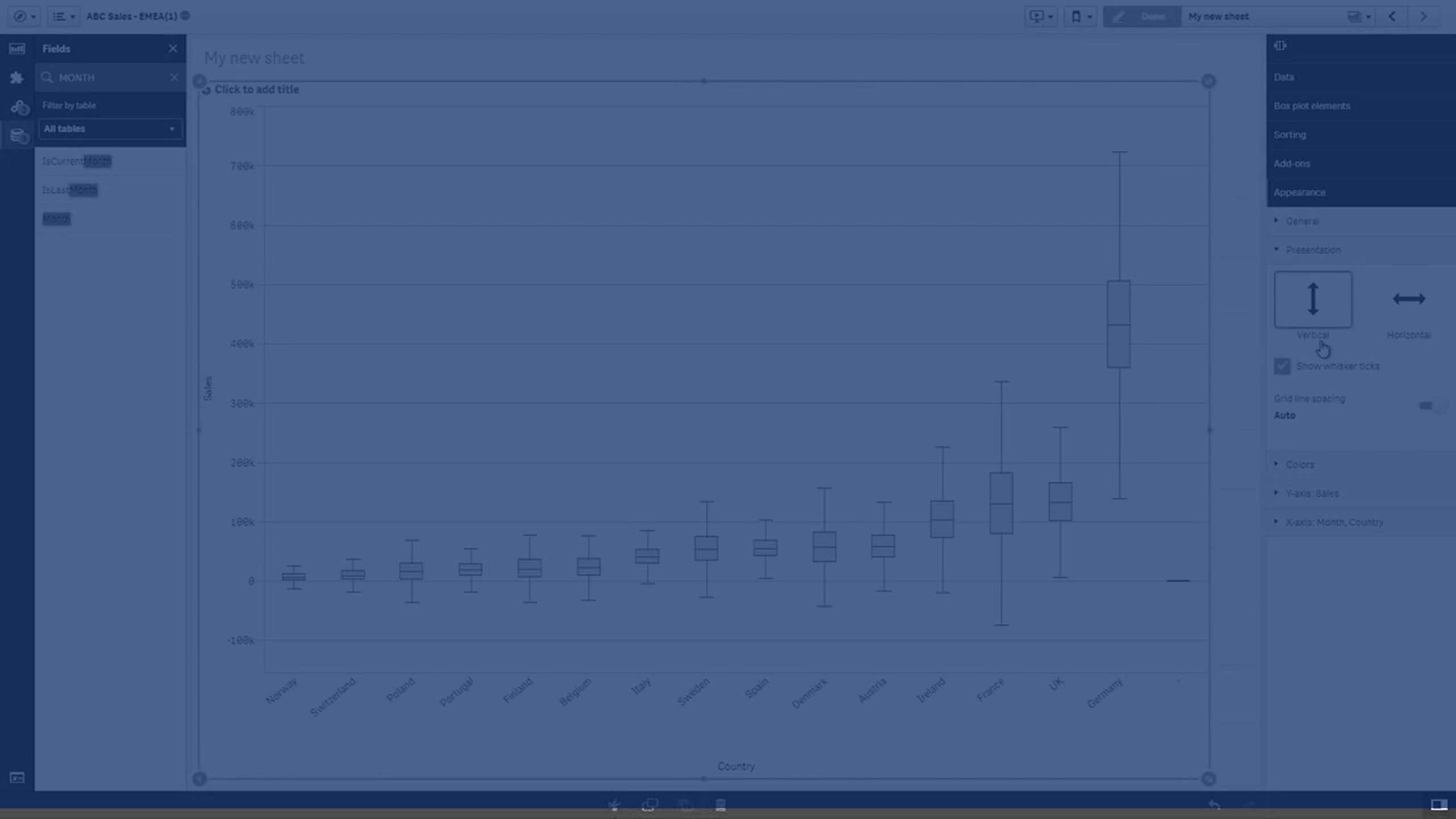The box plot is suitable for comparing range and distribution for groups of numerical data, illustrated by a box with whiskers, and a center line in the middle. The whiskers represent high and low reference values for excluding outlier values.

You can define the box start and end points, and whiskers ranges with a few different presets, or define your own settings using expressions.

- First whisker
- Box start
- Center line
- Box end
- Last whisker
When to use it
The box plot is suitable for comparing range and distribution for groups of numerical data.
Advantages: The box plot organizes large amounts of data, and visualizes outlier values.
Disadvantages: The box plot is not relevant for detailed analysis of the data as it deals with a summary of the data distribution.
Creating a box plot
You can create a box plot on the sheet you are editing.
In a box plot you need to use one or two dimensions, and one measure. If you use a single dimension you will receive a single box visualization. If you use two dimensions, you will get one box for each value of the second, or outer, dimension.
By default, the Standard (Tukey) preset is used.
Do the following:
- From the assets panel, drag an empty box plot to the sheet.
-
Add the first dimension.
This is the inner dimension, which defines a box.
-
Add a second dimension.
This is the outer dimension, which defines the boxes shown on the dimension axis.
-
Click Add measure and create a measure from a field. The measure does not have to contain an aggregation.
When you have created the box plot, you may want to adjust its appearance and other settings in the properties panel.
When you have created the bar chart, you may want to adjust its appearance and other settings in the properties panel. For information about styling, see Styling the box plot. For information about customizing other aspects of the chart's appearance, see Changing the appearance of a visualization.
Styling the box plot
You have a number of styling options available under Appearance in the properties panel.
Click Styling under Appearance > Presentation to further customize the styling of the chart. The styling panel contains various sections under the General and Chart tabs.
You can reset your styles by clicking next to each section. Clicking
Reset all resets styles in both General and Chart.
For general information about styling an individual visualization, see Applying custom styling to a visualization.
Customizing the text
You can set the text for the title, subtitle, and footnote under Appearance > General. To hide these elements, turn off Show titles.
The visibility of the different labels on the chart depends on chart-specific settings and label display options. These can be configured in the properties panel.
You can style the text that appears in the chart.
Do the following:
-
In the properties panel, expand the Appearance section.
-
Under Appearance > Presentation, click
Styling.
-
On the General tab, set the font, emphasis style, font size, and color for the following text elements:
-
Title
-
Subtitle
-
Footnote
-
-
On the Chart tab, set the font, font size, and color for the following text elements:
-
Axis title: Style the titles on the axes.
-
Axis label: Style the labels on the axes.
-
Customizing the background
You can customize the background of the chart. The background can be set by color and image.
Do the following:
-
In the properties panel, expand the Appearance section.
-
Under Appearance > Presentation, click
Styling.
-
On the General tab of the styling panel, you can select a background color (single color or expression), and also set the background to an image from your media library.
When using a background image, you can adjust image sizing and position.
Customizing the border and shadow
You can customize the border and shadow of the chart.
Do the following:
-
In the properties panel, expand the Appearance section.
-
Under Appearance > Presentation, click
Styling.
-
On the General tab of the styling panel, under Border, adjust the Outline size to increase or decrease the border lines around the chart.
-
Select a color for the border.
-
Adjust the Corner radius to control the roundness of the border.
-
Under Shadow in the General tab, select a shadow size and color. Select None to remove the shadow.
Changing the definition of the box plot
You can use one of the three presets, found under Box plot elements in the properties panel, to define your box plot.
-
Standard (Tukey)
This preset is based on the original box plot definition by J. Tukey. The center line represents the median (second quartile), and the box start and end points represent the first and third quartiles. Whisker length can be set to 1, 1.5 or 2 inter-quartile ranges. An inter-quartile range represents the difference between the first and third quartiles.
-
Percentile-based
This preset is also defined with the box start and end points representing the first and third quartiles, and the center line representing the median, but the whisker length is adjusted by setting a percentile based whisker position.
-
Standard deviation
This preset is based on standard deviations, with the center line representing the average value, and the box start and end points representing one standard deviation variance. You can set the whisker length to a multiple of standard deviations.
You can also define a custom box plot where you set the value of each box plot element using an expression.
